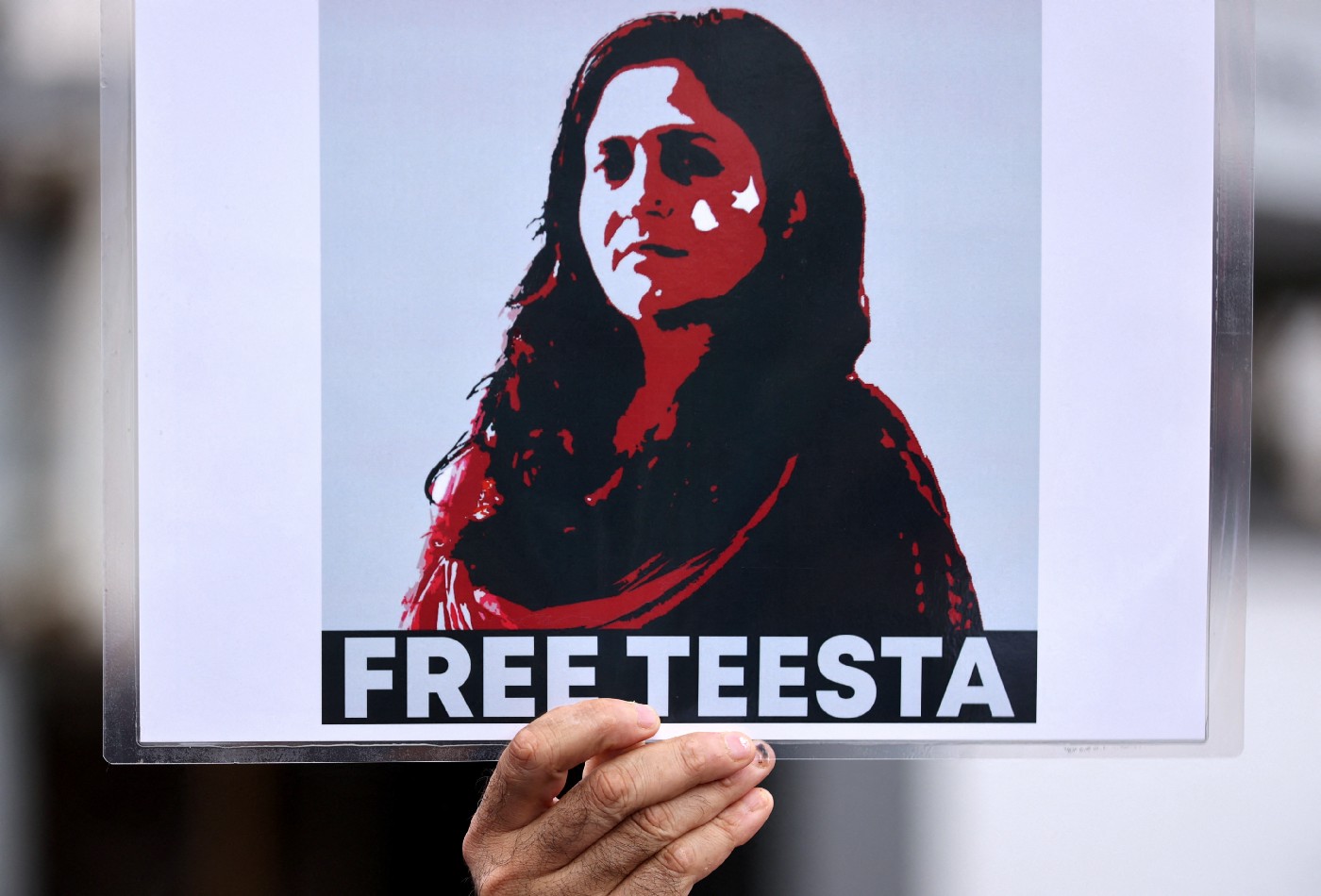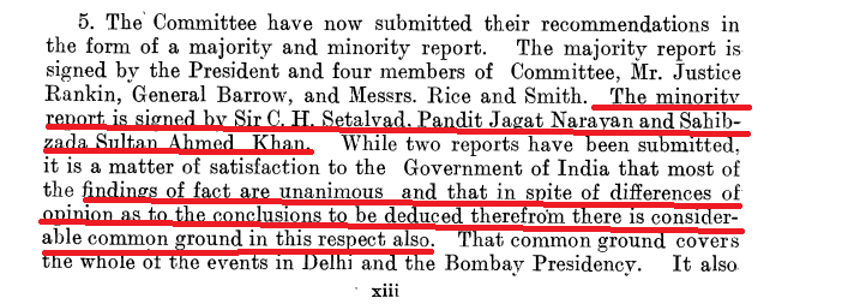Twitter campaign targeting detained Indian activist based on misleading tweet
Teesta Setalvad, arrested for probing Modi’s role in 2002 Gujarat riots, targeted online by BJP supporters and other Hindu nationalists.
Twitter campaign targeting detained Indian activist based on misleading tweet

BANNER: A protestor holds a placard demanding the release of activist Teesta Setalvad after she was arrested at her home by the anti-terrorism wing of the Gujarat police, during a protest in Mumbai, India, June 27, 2022. (Source: REUTERS/Francis Mascarenhas)
A campaign targeting a detained human rights activist who had spent two decades trying to hold Indian Prime Minister Narendra Modi accountable for his role in the deadly 2002 Gujarat riots is based on a misleading tweet about her family’s history in Indian politics. After the state of Gujarat accused Teesta Setalvad of allegedly fabricating evidence to implicate Modi, prominent influencers associated with the ruling Bhartiya Janata Party (BJP) began to malign her and her family by spreading false information.
Setalvad was arrested by the Anti-Terrorism Squad of the Gujarat Police on June 25, 2022, on the grounds that she conspired with others to frame Modi as being involved in the 2002 communal riots. Her arrest came a day after the Supreme Court of India dismissed a plea by the wife of a riot victim who sought to judicially re-examine whether Modi and other top state officials were involved in a criminal conspiracy to unleash the violence. Setalvad’s NGO, Citizens for Justice and Peace, was a co-petitioner in that case.
Setalvad’s investigation of the riots
The 2002 Gujarat riots, a three-day period of frenzied inter-religious violence that left over 1,000 people dead and more than 2,500 injured, took place when Narendra Modi was chief minister of Gujarat. The violence was largely centered on the Muslim population of the state. The riots catapulted Modi to the national stage in India, where he was equally praised and criticized for his inability to control the pogrom.
Granddaughter of India’s first attorney general, Teesta Setalvad followed in her family’s footsteps. She began working as a journalist in the 1980s and witnessed multiple incidents of communal violence across the country. Moved by what she saw, Setalvad and her husband set up a monthly magazine called Communalism Combat to document rising religious intolerance in India. In the aftermath of the 2002 Gujarat riots, Setalvad set up her NGO, Citizens for Justice and Peace, which documented the atrocities and represented several victims in court, accusing Modi and other state officials of complicity and inaction. Setalvad also testified at a June 2002 hearing of the US Commission on International Religious Freedom on the BJP’s role in the riots. Over the years, Setalvad and her NGO have come under government scrutiny for alleged misappropriation of funds, witness tampering and fabrication of evidence. The targeting of Setalvad has prompted concerns by human rights activists and organizations that she is being framed for speaking out against Modi.
Targeted on all fronts
Prior to Setalvad’s arrest, India’s Supreme Court broke away from precedent by directly naming Setalvad when it dismissed the riot victim case, accusing her of “exploiting the emotions and sentiments of appellant” for her “ulterior design” in its judgment. Hours later, India’s Union Home Minister Amit Shah, who was a top Modi aide during the 2002 riots, went on national television claiming that Setalvad and her NGO had put forward “baseless information” about Modi’s role to investigative agencies and “created pressure” to have their evidence accepted by authorities.
As attention swirled around the court’s stinging observations and Shah’s accusatory interview, the police picked up Setalvad from her house in the dead of the night. Taking a cue from the allegations against Setalvad, a host of senior government officials and members of the BJP and the larger Hindu nationalist ecosystem in India soon began to paint her as being part of a “network of entrenched interests that banded together to play politics and capitalize during the 2002 Gujarat riots,” as one right-wing news portal claimed. The tactic is commonly used by the far right in India to discredit human rights actors by accusing them of having vested interests that stem from hurting national interest.
Invoking her family history
What is notable to Setalvad’s case is how the campaign projected her as coming from a family of anti-India actors. It began when Kanchan Gupta, senior adviser at the Ministry of Information and Broadcasting, posted a tweet claiming that Setalvad’s great-grandfather, Sir Chimanlal Harilal Setalvad, exonerated British General Reginald Dyer, who in 1919 was responsible for ordering troops to fire on Indian civilians in Amritsar in what became known as the Jallianwala Bagh Massacre.
“Fraud activist and ‘riot relief fund’ scamster Teesta Setalvad is great granddaughter of Chimanlal Harilal Setalvad who was member of the infamous ‘Hunter Commission’ on Jallianwala Bagh massacre, ” Gupta tweeted. “Commission gave clean chit to General Dyer who ordered the firing on civilians.”
With more than 4,200 retweets and 9,200 likes, the tweet went viral, and was soon amplified by prominent Modi supporters. According to media monitoring platform Meltwater, Kanchan Gupta’s original tweet had a reach of 316,000 Twitter users. It also inspired thousands of other tweets targeting Setalvad over the next several days.
For example, Akhilesh Mishra, CEO of BlueKraft Digital Foundation, a non-profit organization with documented ties to the Modi government, published a series of tweets aimed at discrediting Setalvad. “Teesta Setalvad is the archetypal defender of Constitution whose parents/grandparents/great grandparents were British collaborators,” he wrote in one tweet. In another, he added, “Teesta’s great grandfather was the Indian collaborator in the committee constituted to whitewash crimes of Gen. Dyer.”

Prominent Hindu nationalist academic Madhu Purnima Kishwar used similar language when accusing Setalvad’s grandfather of having “exonerated” Dyer.
The Twitter account @eOrganiser, affiliated with the Hindu nationalist paramilitary organization Rashtriya Swayamsevak Sangh (RSS), used language nearly identical to Gupta’s original tweet when they wrote, “Hunter Commission gave a clean chit to General Dyer who ordered the firing on civilians.
Similar language could also be found in tweets responding to Twitter threads attempting to defend Setalvad. When veteran Indian politician Digvijaya Singh tweeted his support of her, BJP Voice (@bjpsamvad) responded by saying that Setalvad’s grandfather “gave clean chit to General Dyer,” adding, “Get your facts right, mister.”

As these and thousands of other posts gained traction, a narrative emerged: Teesta Setalvad came from a family of British sympathizers that had allegedly played a role in whitewashing a British massacre of Indian civilians, and hence was herself “anti-India.”
Fact-checking Gupta’s tweet
While Teesta Setalvad’s great grandfather, Sir Chimanlal Harilal Setalvad, was part of the commission that investigated General Dyer, he did not exonerate him, as the tweet campaign implied. In fact, he co-wrote a minority opinion that was highly critical of Dyer.
The Hunter Commission was instituted in 1919 to probe the Jallianwala Bagh massacre. On April 13, 1919, a large crowd of non-violent demonstrators had gathered at the Jallianwala Bagh park in the northern Indian state of Punjab to protest unjust British laws. As they celebrated the spring harvest festival of Baisakhi and proclaimed their wish to be freed from the clutches of colonialism, British troops, upon the instructions of General Dyer, opened fire into the unarmed crowds. Estimates of the death toll from the massacre vary from 379 to over 1,000. After sustained outrage, the British government established a committee to investigate the incident; the commission, headed by former solicitor-general of Scotland Lord William Hunter, published a report on its findings. Sir Chimanlal Harilal Setalvad, an advocate of the Bombay High Court and Setalvad’s great-grandfather, was a member of that commission.

After a year of inquiry, the committee produced two reports — a majority and a minority one — owing to differences of opinion among the members over the conclusions made from the evidence. Both reports held General Dyer responsible for the events of April 13, 1919, but they differed on whether the circumstances necessitated the use of violence. The minority report was signed by Setalvad’s grandfather and the two other Indian members of the committee.

The minority report authors criticized General Dyer, describing his actions as “inhuman and un-British and as having caused great disservice to British rule in India.” They also differed with the majority opinion which held that General Dyer thought he was doing the “right thing.” By participating in the minority opinion of the commission, Teesta Setalvad’s great-grandfather condemned General Dyer for ordering the massacre rather than exonerated him.

Following the submission of the report, General Dyer was removed from duty, and he died a few years later.
Cite this case study:
Nishtha Gupta, “Twitter campaign targeting detained Indian activist based on misleading tweet,” Digital Forensic Research Lab (DFRLab), July 20, 2022, https://medium.com/dfrlab/twitter-campaign-targeting-detained-indian-activist-based-on-misleading-tweet-ea0bb40b83e7.

